by W.S. Cranshaw * (6/13)
Quick Facts…
- Several Insects and mites are commonly found on honeylocust trees in Colorado. However, they rarely affect the health of the tree.
- Honeylocust podgall midge deforms new leaves of honeylocust in late spring. One to two insecticide applications when new growth starts can limit this injury.
- Plant bugs also feed on new growth and compete with podgall midge.
- Late season buildup of spider mites is common on honeylocust. Water sprays, insecticidal soaps and certain miticides can limit this injury.
Several Insects and mites feed on honeylocust trees in Colorado. Their feeding can cause conspicuous injuries that may make the trees unattractive. Heavy infestations can reduce tree growth rate and vigor and cause some twig dieback. However, it is extremely rare that these injuries alone permanently injure the trees. Plant diseases, notably Thryonectria and Tubercularia cankers (fact sheet 2.939, Honeylocust Diseases), are far more important to the health of honeylocust.
Honeylocust Plant Bugs
 |
Figure 1: Adult honeylocust plant bug. |
Honeylocust plant bugs commonly infest honeylocust in late spring. This common damaging species of plant bug is generally green. When immature, it superficially resembles an aphid but is much more active. Injured foliage shows yellow or brown spotting. Leaves become twisted, and twig dieback can occur following heavy infestations. The honeylocust plant bug particularly favors new foliage.
This insect can indirectly limit honeylocust podgall midge by destroying gall-susceptible new growth. A single generation of these Insects occurs, with damage peaking in late May or early June. New growth produced after this time emerges normally.
Chemical controls are recommended only when spring growth is seriously threatened, because regrowth occurs in June when insect populations diminish. Orthene, carbaryl (Sevin) pyrethroid insecticides (permethrin, bifenthrin, cyhalothrin) and imidacloprid have been shown to control plant bugs.
Honeylocust Podgall Midge
The immature stages (larvae) of a small fly, the honeylocust podgall midge, commonly cause distortions of new honeylocust growth. Infested leaflets curl and thicken, forming small “pod galls” instead of expanding normally. Inside each pod gall, two to eight cream-colored larvae or pupae may be found. After the adult midges emerge, the galls drop,
leaving bare leaf stalks.
The honeylocust podgall midge has multiple annual generations. It is most active from the time of first shoot growth through midsummer. Infestations occasionally can be severe enough to temporarily destroy all new growth. Leaflets that have already expanded are not injured by the insect. All common honeylocust varieties appear to be susceptible.
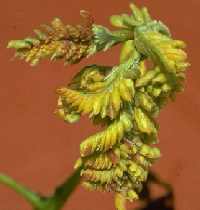 |
Figure 2: Severe galling produced by the honeylocust podgall midge. |
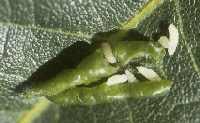 |
Figure 3: Honeylocust podgall midge larvae. |
Natural controls include severe weather, predatory plant bugs, and a small parasitic wasp that attacks young midge larvae. Heavy midge infestations often collapse when new growth ceases and the trees are no longer attractive to the egg-laying adult midges. In the absence of suitable egg-laying sites, the adult midges apparently go into an inactive diapause stage,
renewing activity the following spring.
Chemical controls have been only moderately effective. Some reduction of gall production can result from applications of pyrethroids (permethrin, bifenthrin), Spinosad, or imidacloprid during egg-laying periods. Control of the earliest midge generations is most important because that is when most leaf growth is produced. The first generation appears in spring with the first flush of new growth. The second and subsequent generations follow at about three to four week intervals. Repeat insecticide applications to protect the newly expanding leaflets.
Honeylocust Spider Mite
The honeylocust spider mite is closely related and similar in habits to the common twospotted spider mite. Both are barely visible to the unaided eye and feed on the undersides of leaves. During midsummer, honeylocust spider mite populations greatly increase. The foliage of infested trees turns bronze. Injured leaves often drop prematurely.
Problems with spider mites tend to be much greater on street trees and in other dry, drought-stressed sites. Regular watering during hot summer months helps to reduce mite populations and lessen tree damage. Natural spider mite predators (predatory bugs, predatory thrips) often contribute to a great reduction of mite populations by late August, but chemical controls may be needed to prevent injury. Fortunately, honeylocust spider mites are controlled more easily than the twospotted mite that causes problems on other ornamental plants.
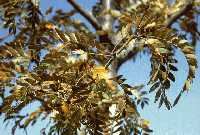 |
Figure 4: The honeylocust spider mite causes general yellowing of the foliage in midsummer. |
Bifenthrin (Talstar) and Orthene are among the most widely available miticides. Dormant season oil treatments also can suppress honeylocust spider mites. However, they need to be applied to both the trunk and the crown, because overwintering mites are present in both sites. Repeat applications of insecticidal soaps or spray oils also can be effective.
Eriophyid Mites
Minute eriophyid mites commonly are observed on honeylocust and are thought to contribute to leaf bronzing. Because these eriophyid mites occur on leaves (versus in galls), they are called “leaf vagrant” mites. Carbaryl (Sevin, etc.), insecticidal soaps, and oils can control these mites on honeylocust.
Leafhoppers
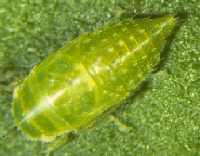 |
Figure 5: Leafhopper. |
A common species of green leafhopper infests honeylocust and many other trees. Peak populations occur in late spring, often together with plant bugs. Visible damage is minimal and rarely results in more than a scattered yellow spotting of the foliage. A temporary honeydew problem also may occur during heavy infestations.
Leafhoppers on honeylocust appear to have two generations per year. However, some adult leafhoppers are found in late July. Control is never necessary but is possible with most shade tree insecticides.
Blister Beetles
Ash-gray blister beetles suddenly may occur in large numbers on trees, occasionally causing serious defoliation over parts of the tree. Infestations tend to occur most frequently in late June or early July and end as suddenly as they begin. If severe defoliation is threatened, control can easily be accomplished using any of the insecticides commonly used for insect control on trees and shrubs.
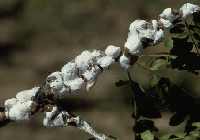 |
Figure 6: Mature female cottony maple scales with egg sac. |
Cottony Maple Scale
Cottony maple scale occasionally builds up in large numbers on branches and leaves of honeylocust, becoming quite conspicuous as egg sacs swell in June and July. The overwintering stage of this scale (mated female) can be controlled with dormant oil applications made before new growth in spring. These treatments also can help suppress spider mites, eriophyid mites and plant bugs that overwinter on trees.
Newly hatched crawlers generally appear in late June through July and can be controlled at that time with Sevin, Orthene or various pyrethroids. Imidacloprid (Merit) applied as a soil systemic treatment should also be effective, provided sites are irrigated. Natural controls generally maintain cottony maple scale at nondamaging levels and sustained infestations lasting more than one season are very rare.
Honeylocust Borers
The various honeylocust borers are metallic or longhorned beetles that spend larval stages tunneling under the bark. This injury can contribute to honeylocust decline, but borer problems are rarely the fundamental cause of the decline. The most common species in honeylocust are thought to emerge and lay eggs during June.
Honeylocust borers can attack and develop successfully only in trees already stressed due to drought, root pruning, disease or other causes. Most borer activity occurs in areas of existing cankers. External evidence of a honeylocust borer infestation include “weeping” at wounds and the small circular to oval exit holes made by the adult beetles as they emerge from the trunk.
Proper watering, tree care and, in particular, wound prevention are the most important techniques for reducing problems with honeylocust borers. Usually, this is sufficient.
Supplemental insecticidal controls should consist of maintaining a protectant insecticide on the tree trunk during the egg-laying and egg-hatch period in early summer. Permethrin (Astro) is used for control of related borers attacking other shade trees. Alternately, soil drench applications of imidacloprid can be effective if applied in spring to trees not already
damaged badly by borers.
* Colorado State University Extension entomologist and professor, bioagricultural sciences and pest management. 6/00. Revised 6/13.
Colorado State University, U.S. Department of Agriculture and Colorado counties cooperating. Extension programs are available to all without discrimination. No endorsement of products mentioned is intended nor is criticism implied of products not mentioned.
Go to top of this page.





